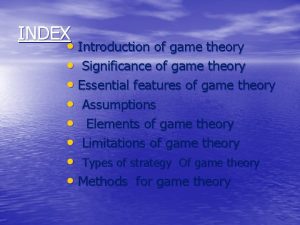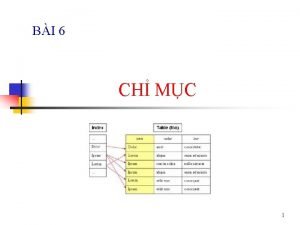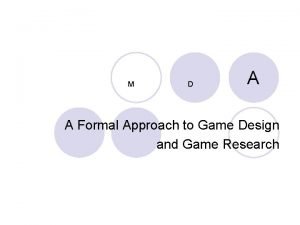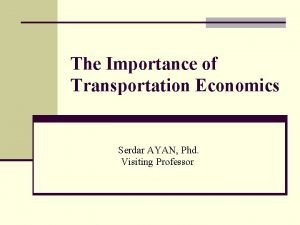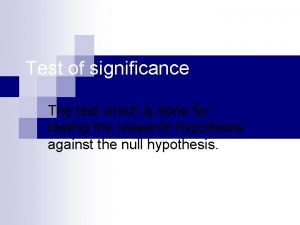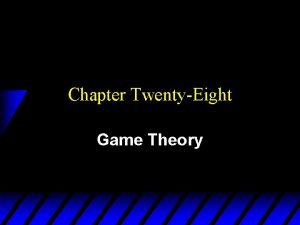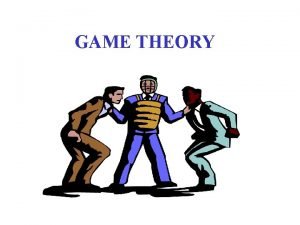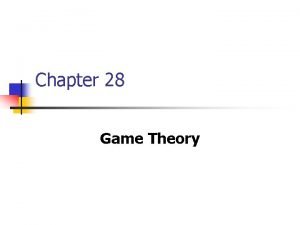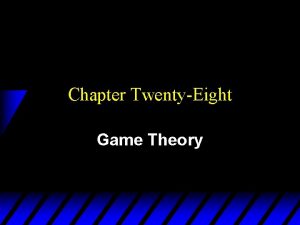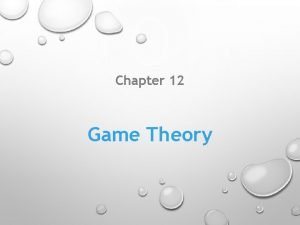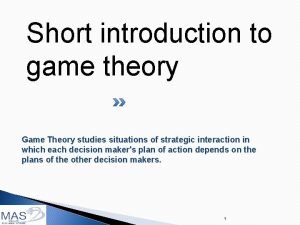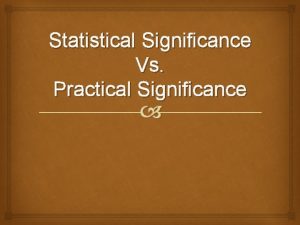INDEX Introduction of game theory Significance of game




































- Slides: 36

INDEX • Introduction of game theory • Significance of game theory • Essential features of game theory • Assumptions • Elements of game theory • Limitations of game theory • Types of strategy Of game theory • Methods for game theory

INTRODUCTION • Game theory was developed by Prof. John Von Neumann and Oscar Morgenstern in 1928 game theory is a body of knowledge that deals with making decisions when two or more rational and intelligent opponents are involved under situations of conflict and competition. The approach of game theory is to seek to determine a rival’s most profitable counter-strategy to one’s own best moves. It helps in determining the best course of action for a firm in view of the expected counter moves from the competitors.

What is Game Theory? Game theory is a type of decision theory which is based on reasoning in which the choice of action is determined after considering the possible alternatives available to the opponents playing the same game. The aim is to choose the best course of action, because every player has got an alternative course of action

Significance of game theory 1. Game theory is a kind of decision theory which is based on the choice of action. And choice of action is determining after considering the possible alternatives available to the opponent. 2. It involves the player decision i. e. decision makers who have different goals and objectives. 3. The game theory determine the rules of rational behavior of these players in which the outcomes are dependent on the actions of the interdependent players.

Essential features of game theory 1. There is Finite number of competitors. 2. The list of Finite number of possible 3. 4. 5. 6. course of action is available to each players. Each player has the Knowledge of alternatives. Each player makes a choice, i. e. , the game is played. The play is associated with an outcome known as gain. The possible gain or loss of each player depends upon the choice of his opponent.

Assumptions • (1) Each decision maker has available to him two or more well-specified choices or sequences of choices. • (2) Every possible combination of plays available to the players leads to a well-defined end-state (win, loss, or draw) that terminates the game. • (3) A specified payoff for each player is associated with each end-state.

• (4) Each decision maker has perfect knowledge of the game and of his opposition. • (5) All decision makers are rational; that is, each player, given two alternatives, will select the one that yields him the greater payoff.

The Two-Person, Zero-Sum Game • Two person zero sum game is the situation which • • involves two persons or players and gains made by one person is equals to the loss incurred by the other. For example there are two companies coca-cola and Pepsi and are struggling for the larger share in the market. Now any share of the market gained by the cocacola company must be lost share of Pepsi and therefore the sums of the gains and losses equals zero.

n-persons game. A game involving n persons is called a n person game. In this two person game are most common. When there are more than two players in a game, obviously the complexity of the situation is increased. Pay offs. Outcomes of a game due to adopting the different courses of action by the competing players in the form of gains or losses for each of the players is known as pay offs.

• Pay off matrix In a game , the gains and losses, resulting from different moves and counter moves, when represented in the form of a matrix is known as pay off matrix or gain matrix. This matrix shows how much payment is to be made or received at the end of the game in case a particular strategy is adopted by a player. Pay off matrix shows the gains and losses of one of the two players, who is indicated on the left hand side of the matrix. Negative entries in the matrix indicate losses. This is generally prepared for the maximizing player. However’ the same matrix can be interpreted for the other players also.

As in a zero sum game, the game of one player represents the losses of the other player , and vice versa. Thus, the pay off matrix of Mr. A is the negative pay off matrix for Mr. B. The other player is known as the minimizing player. He is indicated on the top of the table. • Decision of a game : In a game theory best strategy for each player is determined on the basis of some criteria. Since both the players are expected to be rational in their approach , this is known as the criteria of optimality. The decision criteria in game theory is criteria of optimality i. e. maximin and minimax.

Limitations of game theory • The assumption that the players have the knowledge about their own • • • pay-offs and pay-offs of others is rather unrealistic. He can only make a guess of his own and his rivals’ strategies. As the number of maximum and minimize show that the gaming strategies becomes increasingly complex and difficult. In practice, there are many firms in an oligopoly situation and game theory cannot be very helpful in such situation. The assumptions of maximum and minimize show that the players are risk-averse and have complete knowledge the strategies. These do not seen practical. Rather than each player in an oligopoly situation working under uncertain conditions, the players will allow each other to share the secrets of business in order to work out a collusion. Thus, the mixed strategies are also not very useful.

Strategy • It is pre- determined rule by which each player decides his course of action from his list available to him. How one course of action is selected out of various courses available to him is known as strategy of the game. • TYPES OF STRATEGY : There are two types of strategy are employed 1. Pure strategy : it is predetermined course of action to be employed by the player. The player knew it in advance. It is usually represented by a number with which the cause of action is associated.

• : Mixed strategy In mixed strategy the player decides his course of action in accordance with some fixed probability distribution. Probability are associated with each course of action and the selection is done as per these probabilities. In mixes strategy the opponent cannot be sure of the course f action to be taken on any particular occasion. • Decision of a game : In a game theory, best strategy for each player is determined on the basis of some rules. Since both

The Maximin –Minimax Principle Maximin Criteria : The maximizing player lists his minimum gains from each strategy and selects the strategy which gives the maximum out of these minimum gains. Minimax Criteria : The minimizing player lists his maximum loss from each strategy and selects the strategy which gives him the minimum loss out of these maximum losses.

• Value of game : In game theory, the concept value of game is considered as very important. The value of game is maximum guaranteed gain to the maximizing player if both the players use there best strategy. It refers to the average pay off per play of the game over the period of time. • SADDLE POINT : the saddle point in a pay off matrix is one which is the smallest value in its row and the largest in its column The saddle point is also known as equilibrium point in theory of games. An element of a matrix that is simultaneously minimum of the row in which it occurs and the maximum of the column in which it occurs is a saddle point of the matrix game.

In a game having a saddle point optimum strategy for a player X is always to play row containing saddle point and for a player Y to play the column that contains saddle point. The following are the steps required to find out saddle point : 1. Select the minimum value of each row & put a circle around it. 2. Select the maximum value of each column and put square around it. 3. The value with both circle and square is the saddle point.

TYPES OF PROBLEM 1. Games with pure strategies or Two person Zero sum game with Saddle point Or Two person Zero sum game with pure strategy : In case of pure strategy , the maximizing player arrives at his optimal strategy on the basis of maximin criterion. The game is solved when maximin value equals minimax value. FIRM Y Example : Y 3 FIIRM X X 1 X 2 Y 1 Y 2 4 20 18 12 6 10

Firm Y X 1 Firm X Y 1 Y 2 4 20 18 12 Y 3 6 10 X 2 The saddle point Exits and the value of game (v) is 10 and the pure strategy for X is X 2 and for Y is Y 3

Games with mixed strategies • All game problems where saddle point does not exists are taken as mixed strategy problems. Where row minima is not equal to column maxima, then the different methods are used to solve the problems. Both players will use different strategies with certain probability to minimize. • Methods : 1. ODDS method (2 x 2 game without saddle point) 2. Dominance method 3. Sub games method For (mx 2) or (2 xn) matrices. 4. Equal gains method. 5. Linear programming method- graphic method

ODDS METHOD • Step 1 Find out the difference in the value of in cell (1, 1) • • • and the value in cell (1, 2) of the first row and place it in front of second row. Step 2 find out the difference in the value of cell (2, 1) and (2, 2) of the second row and place it in front of first row. Step 3 find out the difference in the value cell (1, 1) and (2, 1) of the first column and place it below the second column. Step 4. Similarly find the difference between the value of the cell (1, 2) and the value in cell (2, 2) of the second column and place I below the first column.

The above odds or differences are taken positive (ignoring the negative sign) Mathematically : strategy X 1 X X 2 0 dds Y 1 Y 2 odds a 1 a 2 (b 1 -b 2) b 2 (a 1 -a 2) b 1 (a 2 -b 2) (a 1 -b 1)

The valve of game is determined with the help of following equation : Valve of game = a 1(b 1 -b 2) + b 1(a 1 -a 2) (b 1 -b 2) + (a 1 -a 2) Probabilities for x 1 = b 1 -b 2 (b 1 -b 2) = (a 1 -a 2) Probabilities for Y 1 = a 2 -b 2 (a 2 -b 2) + (a 1 -b 1) X 2 = a 1 -a 2 (b 1 -b 2) + (a 1 -a 2) Y 2= a 1 -b 1 (a 2 -b 2) + (a 1 -b 1)

Dominance Method • Dominance method is also applicable to pure strategy and mixed strategy problems. In pure strategy the solution is obtained by itself while in mixed strategy it can be used for simplifying the problems. • Principle of dominance : The principle of dominance states that if the strategy of a player dominates over the other strategy is ignored because it will not effect the solution in any way. For the gainer point of view if a strategy gives more gain than the another strategy , then first strategy dominates over the other and he second strategy can be ignored altogether. So determination of superior or inferior strategy is base d on the objective of player.

• For deleting the ineffective rows and columns the following general rules are to be followed : 1. If all the elements of ith row of a pay off matrix are less than or equal to(<) the corresponding each element of the other jth row then the player A will never choose the ith strategy or ith row is dominated by he jth row. Then delete ith row. 2. If all the elements of a column say jth column are greater than or equal to the corresponding elements of any other column say ith column the ith column is dominated by jth column.

• A pure strategy of a player may also be dominated if it is inferior to some convex combination of two or more pure strategies. As a particular case, if all the elements of a column are greater than or equal; to the average of two or more other columns then this column is dominated by the group of columns. Similarly if all the elements of row are less than or equal to the average of two or more rows then this row is dominated by other group of row. • By eliminating some of the dominated rows a columns and if the game is reduced to 2 x 2 form

Sub –games Method (in case 2 xn or mxn matrices • A game where one player has two alternatives while the other player has more than two alternatives. In case of 2 xn or mx 2 matrices this can be solved by Sub games method. When there is no saddle point or it can not be reduced by dominance method then in such situation sub games method is very useful. This technique is discussed as blow. • PROCEDURE 1. Step 1. Divide the mx 2 or 2 x n game matrix into as many 2 x 2 sub games as possible. 2. Step 2. taking each game one by one and finding out the saddle point of each game and then that sub game has pure strategies. 3. Step 3. in case there is no saddle point and then that sub game should be solved by odds method.

Probability method or equal gains method • (solution of 2 x 2 matrix without saddle point) • In case of game not having saddle point, each player • has to use mixed strategies. As the players are reported to be rationale in their approach, the selection of their combination of strategies will be done in such a way that the net gain is not influenced by the selection of any combination of strategy by the opponent. In this, player select each of the available strategies for certain proportion of the time i. e. each player selects a strategy with some probability.

LPP-Graphic Method- for (2 xm) and (nx 2) • Graphic method is applicable to only those games in • • • which one of the players has two strategies only. Through sub game method provides simple approach , but in case ‘n’ or ‘m’ is large then a graphic method is relatively fast and easy. The following are the steps involved in this method. Step 1 : the game matrix of 2 xm or nx 2 sub matrices. Step 2. next taking the probabilities of the two alternatives of the first player say A as p 1 and (1 -p 1) then the ne gain of A from the different alternatives strategies of B is expressed with equations.

• Step 3. the boundaries of the two alternatives • • • strategies of the first player are shown by the two parallel line shown on the graph. Step 4. The gain equation of different sub games are then plotted on the graph Step 5. In case of maximizing player A, the point is identified where minimum expected gain is maximized. This will be the highest point out the inter section of the gains lines in the lower envelop In case of minimizing player B, the point where maximum loss is minimized is justified, this will be the lowest point out at the intersection of the equation in the intersection of the equations in the upper envelop.

• Example : solve the following : 3 1 -5 2 5 B 4 0 -1 8 2 8 -4 -1 6 -5 1 A 5

• Since Minimize = Maximinze • Thus, players will use the mixed strategy. • Since we do not have any saddle point Let p 1 the probability of Mr. selecting strategy 1 & hence (1 -p 1) be the probability of Mr. a selecting strategy 2.

If B select strategy 1 2 3 4 5 Expected pay off of A -5(p 1) + 8(1 -P 1)= 13 p 1+8 5(p 1)-4 (1 -p 1) = 9 p 1 -4 0(p 1) + - 1(1 -p 1) +p 1 -1 -1(p 1) +6(1 -p 1) = -7 p 1+6 8(p 1) + -5(1 -p 1)= 13 p 1 -5

1 -p 1 8 B 5 7 7 13 p 1 -5 6 6 B 2 5 2 -4 -5 2 1 -7 p 1+6 1 0 -3 4 3 3 -2 5 9 p 1 -4 4 -1 p 1 8 R B 3 P 1 -1 Q B 4 -1 maximin P Lower envelop -13 p 1+8 B 1 -2 -3 -4 -5

• Since R is the maximize point and here B 1’, B 3 interest. These strategies will be selected & the B resultant matrix is 3 produced. 1 odds A 1 2 odds -5 0 8 -1 1 13 9 5

• V = a 1(b 1 -b 2) + b 1(a 1 -a 2) = (-5 x 9) + (8 X 5) 9+5 (b 1 -b 2) + (a 1 -a 2) A B Probability of selecting strategies no. 1 9/14 1 2 3 1/14 0 3/14 2 5/14 4 5 0 0 = -5 14
 Here b is
Here b is Significance of modulation index
Significance of modulation index Current score of pirate game
Current score of pirate game Game lab game theory
Game lab game theory Liar game game theory
Liar game game theory Liar game game theory
Liar game game theory Optical fibre
Optical fibre Dense secondary index
Dense secondary index Bacteriological index formula
Bacteriological index formula Compare india and sri lanka on the basis of hdi
Compare india and sri lanka on the basis of hdi Diff between step index and graded index fiber
Diff between step index and graded index fiber Simpson's diversity index
Simpson's diversity index Atterberg limits
Atterberg limits Clustered index và non clustered index
Clustered index và non clustered index Game theory and graph theory
Game theory and graph theory The farming game board game
The farming game board game A formal approach to game design and game research
A formal approach to game design and game research Domain co domain and range of a relation
Domain co domain and range of a relation Game development essentials: an introduction
Game development essentials: an introduction An introduction to game studies
An introduction to game studies The westing game introduction
The westing game introduction Apush marbury v madison
Apush marbury v madison Criteria for significance
Criteria for significance Clinical significance of uric acid
Clinical significance of uric acid United states v. nixon significance
United states v. nixon significance Truman doctrine key points
Truman doctrine key points Plessy v ferguson summary
Plessy v ferguson summary What is the significance of the northwest ordinance? *
What is the significance of the northwest ordinance? * The kite runner title significance
The kite runner title significance Economic significance of transportation
Economic significance of transportation Figures of speech in the fur coat
Figures of speech in the fur coat Significance of reynolds number
Significance of reynolds number Abraham lincoln
Abraham lincoln Sherman's march significance
Sherman's march significance Population parameter
Population parameter Test of significance
Test of significance Practical significance example
Practical significance example
